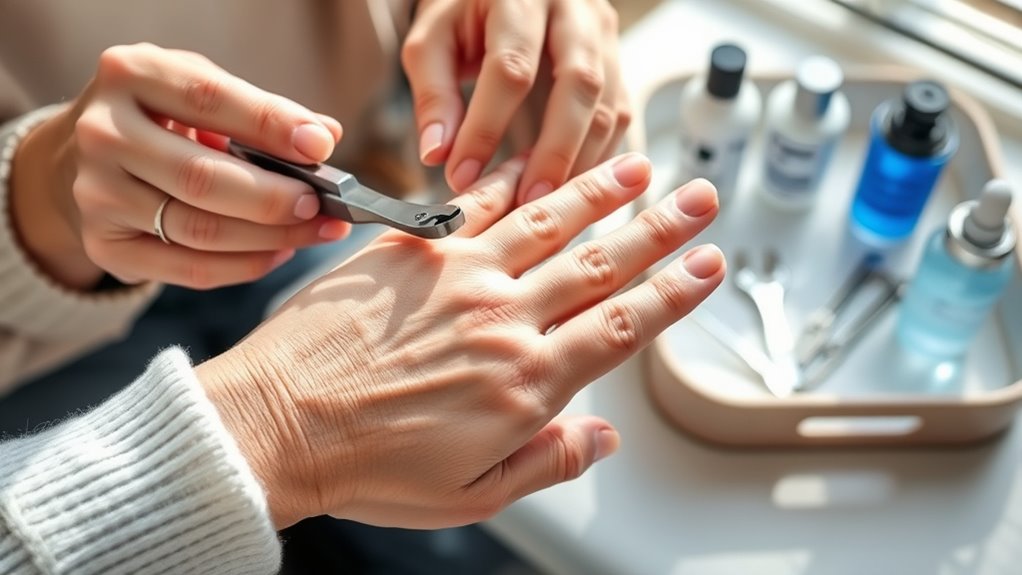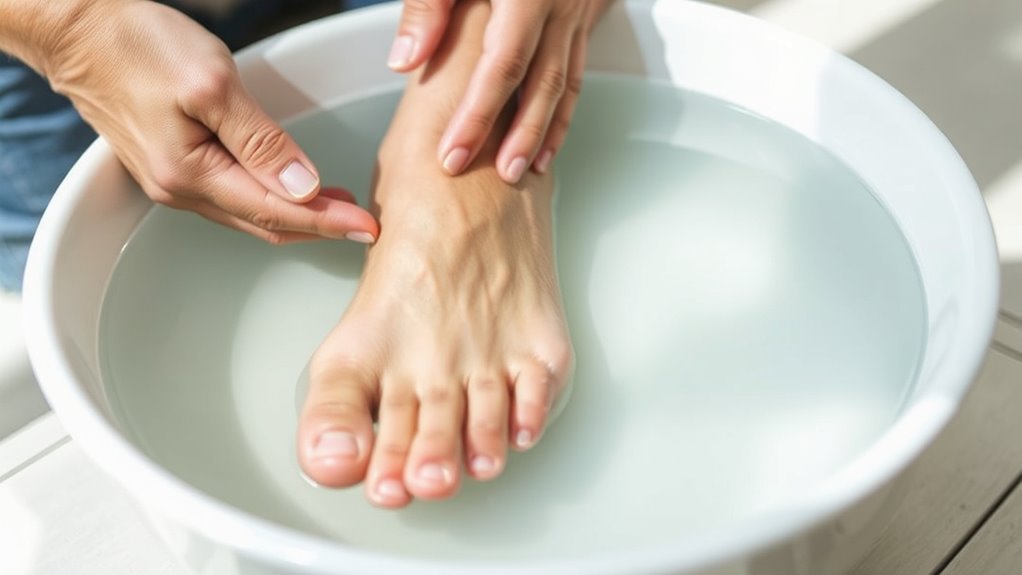If you have diabetes, taking good care of your nails is key to avoiding infections and complications. Make sure to wash and dry your feet daily, trim nails straight across with clean tools, and moisturize regularly. Watch for signs like discoloration or thickening, and visit a healthcare professional if you notice issues. Proper nail care can protect your foot health—keep going to discover more tips to stay safe and healthy.
Key Takeaways
- Maintain strict blood sugar control to reduce nail complications and infection risks.
- Practice daily foot and hand hygiene, and thoroughly dry nails to prevent fungal growth.
- Trim nails straight across with clean, sharp tools, avoiding rounding to prevent ingrown nails.
- Regularly inspect nails for discoloration, thickening, or damage, and seek prompt medical care if issues arise.
- Wear well-fitting supportive shoes, moisturize feet, and avoid walking barefoot to protect overall foot health.
Understanding the Impact of Diabetes on Nail Health

Because diabetes can affect circulation and nerve function, it often leads to changes in your nails’ health. Poor circulatory health reduces blood flow to your toes, making it harder for your body to fight off infections like toenail fungus. This fungus causes thickened, discolored, and brittle nails, which can become painful if left untreated. Additionally, nerve damage can diminish your ability to notice early problems or injuries around your nails, increasing the risk of infection. Over time, these issues can worsen, leading to more serious complications. Understanding how diabetes impacts circulation and nerve health helps you recognize early signs and seek prompt care. Maintaining good blood sugar control and practicing proper foot and nail hygiene are essential for preventing nail problems related to diabetes. Floating on Water can provide relaxation and improve circulation, which may benefit overall foot health.
Daily Nail Care Practices for Seniors

Maintaining a regular nail care routine is essential for seniors with diabetes to prevent infections and complications. Start by washing your hands and feet daily, then gently dry them thoroughly. When trimming nails, use clean, sharp clippers and cut straight across to avoid ingrown nails. Consider using nail strengthening techniques, such as applying a nourishing base coat or strengthening polish, to keep nails resilient. Be cautious with nail polish choices—opt for acetone-free formulas that won’t dry out nails or cause irritation. If you choose to wear nail polish, remove it regularly to inspect your nails for signs of problems. Keep your nails moisturized with a gentle, fragrance-free lotion, especially around the cuticles, to maintain flexibility and prevent cracking. Regular nail inspection is crucial for early detection of issues and maintaining overall nail health. Consistent care helps maintain healthy nails and reduces risks.
Recognizing Signs of Nail Problems and When to Seek Help

Being able to recognize early signs of nail problems is essential for seniors with diabetes, as infections and complications can develop quickly. Watch for nail discoloration, which may appear as yellow, brown, or white spots or streaks. Nail fungus often causes thickening, crumbling, or a distorted shape. Staying informed about AI discoveries can also influence future diagnostic tools and treatments for nail issues.
Safe Nail Trimming and Maintenance Tips

Trimming and maintaining nails safely is essential for seniors with diabetes to prevent infections and injuries. Use clean, sharp nail scissors or clippers to trim nails straight across, avoiding rounded edges that can lead to ingrown nails. Be gentle and don’t cut too close to the skin. If you enjoy nail polish or nail art, choose non-toxic, breathable formulas to reduce skin irritation and allow your nails to breathe. Avoid sharing nail tools to prevent infection. Always wash and dry your hands thoroughly before and after nail care. If your nails are thick or difficult to trim, consider seeking help from a podiatrist. Remember, maintaining proper nail hygiene and avoiding aggressive cosmetic procedures helps keep your feet healthy and safe. Practicing emotional support can also help seniors cope with any anxiety related to foot care routines or health concerns.
Preventing Infections and Protecting Foot Health

Since seniors with diabetes are more prone to foot infections, taking proactive steps to prevent infections is essential. Your footwear choices should prioritize well-fitting shoes that reduce pressure and avoid blisters. Regular moisturizing routines keep your skin supple, preventing cracks that can harbor bacteria. Always inspect your feet daily for cuts, redness, or blisters, and keep them dry. Avoid walking barefoot, even at home, to prevent injuries. Use this table to guide your foot care:
| Best Practices | Why It Matters |
|---|---|
| Wear supportive, comfortable shoes | Prevents blisters and injuries |
| Moisturize daily, but avoid between toes | Maintains skin integrity |
| Check feet regularly for wounds | Detects infections early |
| Keep feet dry and clean | Reduces bacterial growth |
Additionally, understanding the importance of digital literacy can help seniors access educational resources on foot health and safety. These steps help protect your foot health and reduce infection risk.
Frequently Asked Questions
Are Specific Nail Products Recommended for Seniors With Diabetes?
When choosing nail products, you might wonder if specific ones are recommended. For diabetic-friendly nail care, specialized nail products are essential, as they help prevent infections and injuries. Look for gentle, non-irritating formulas and tools designed for sensitive skin and nails. Using these specialized products guarantees safer, more effective nail care, reducing complications. Always consult a healthcare professional for personalized advice on selecting the best diabetic-friendly nail care products.
How Often Should Seniors Schedule Professional Nail Care Appointments?
You should schedule professional nail care appointments every 4 to 6 weeks to guarantee proper nail trimming and infection prevention. Regular visits help catch issues early and keep your nails healthy. If you notice any changes or discomfort, don’t wait—seek professional help sooner. Consistent care reduces the risk of complications, especially for seniors with diabetes. Stay proactive with your nail health to maintain overall well-being and avoid potential infections.
Can Certain Footwear Improve Nail Health for Seniors With Diabetes?
Picture perfect footwear fosters fabulous foot health. The footwear impact is significant—well-fitted shoes prevent pressure points and protect delicate nails. Shoe modifications, like cushioned insoles or wider toe boxes, can minimize friction and reduce risks for seniors with diabetes. By choosing supportive, properly fitted shoes, you help keep nails healthy, prevent infections, and promote overall foot comfort. Remember, good footwear is an essential part of proactive nail and foot care.
What Dietary Changes Support Healthier Nails in Diabetic Seniors?
To support healthier nails, you should focus on incorporating nutrient-rich foods like fruits, vegetables, lean proteins, and whole grains into your diet. These provide essential vitamins and minerals that promote nail strength. Additionally, follow hydration strategies by drinking plenty of water daily, which helps keep nails moisturized and prevents brittleness. Combining good nutrition with proper hydration can markedly improve your nail health and overall well-being.
How Do Humidity and Climate Affect Nail Care Routines for Diabetics?
Humidity fluctuations and climate changes profoundly impact your nail care routine. When humidity levels are high, your skin and nails can become softer or more prone to infections, so you might need to adjust how often you moisturize and inspect your nails. During dry or cold climates, focus on keeping nails moisturized and protected. Adapting your routine to seasonal changes helps prevent complications, especially if you manage diabetes.
Conclusion
Taking care of your nails isn’t just about appearance—it’s about safeguarding your overall health, especially with diabetes. Think of your nails as silent sentinels, revealing clues about your well-being. By following proper care routines, staying vigilant for problems, and seeking help when needed, you can keep infections at bay and enjoy healthier feet. Remember, your nails are the gateway to your health—treat them with the attention they merit to ensure they don’t whisper warnings too late.









